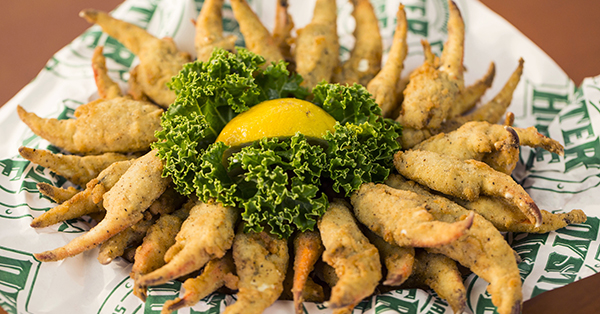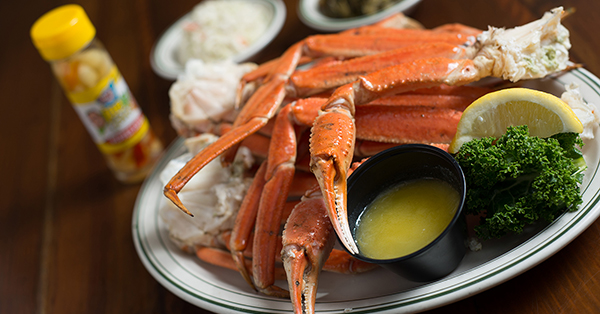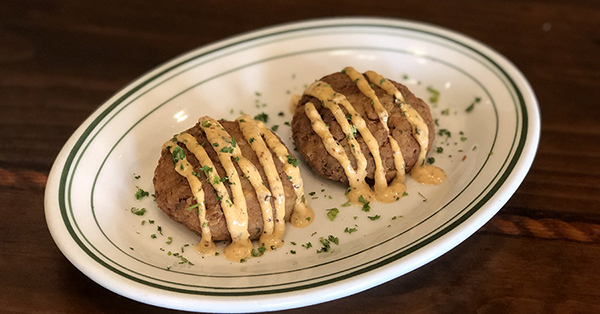Although Gulf Coast natives are among the first to crave their succulent crab claws paired with an ice cold beer, some may take for granted how important this ocean treasure is to our coastal economy as well as our palate.
Alabama crab fishermen land between 1 and 2.5 million pounds of crab out of the Gulf of Mexico and Mississippi Sound each year. And an estimated 5 million pounds of live blue crabs are processed annually in Alabama, with trucks arriving each night from neighboring states like Louisiana, Florida and Mississippi. Known for its smooth, buttery flavor all year round, getting the crab from the crate to your plate is a local legacy and a labor of love.
Flavor is not the only thing that keeps seafood lovers coming back for more crab. Crabmeat is packed with protein, B vitamins and minerals, making it a perfect part of a balanced diet. Crabmeat is a low-calorie protein source that’s rich in omega-3 fatty acids.
David Dekle, seafood expert and co-owner of the Original Oyster House restaurants, says this time of year is ideal for crabmeat and the industry that supports commercial crabbers across the South. Here’s what to know:
- You’ll find the freshest catch between March and November. During these prime months, blue crabs can be found scuttling near the shore or in bay waters along the coast. Crabs migrate to deeper waters once cold weather sets in.
- Crab fishermen start their day around 4:00 a.m. and organize their catch as No. 1, No. 2 and females before sending them to the processors. No. 1’s are the largest males, containing the most meat, while No. 2’s are smaller males. A crab must measure at least five inches point-to-point to be legal. Otherwise it is released.
- A crab ready to shed its shell is called a buster. If it is taken from the water before its new shell has a chance to harden–only about a four-hour window–it will remain in the soft state and retain a unique texture in the cooking process. Soft crab season begins with the first full moon in May.
- State conservation efforts protect baby crabs from being harvested too early. According to Chris Blankenship, Director of the Marine Resources Division of the Alabama Department of Conservation, some rivers, estuaries and parts of upper Mobile Bay near the delta are closed to the use of crab traps. These spots serve as a nursery, giving small crabs a chance to grow before they move out into Mobile Bay and the Mississippi Sound, where they can be harvested. Other areas are closed to crabbing to protect the diamondback terrapin–turtles with concentric, diamond-shaped markings–which can get caught in the crab traps and drown.
- Processing begins with a big pot of water. While many seafood companies boil their crabs immediately, Junior Barbour’s Seafood in Bayou La Batre, Ala.–which supplies crabmeat to Original Oyster House–starts instead with a vat of ice water. This makes separating the dead crabs easier (they float), so you’ll never end up with bad meat on the table. Owner Raymond Barbour says then he boils the crab 1,000 pounds at a time. While on the table for picking, he keeps everything on ice, maintaining a temperature of 36 to 42 degrees the entire process. A fishing village with a seafood processing harbor for boats, Bayou La Batre is often called the Seafood Capital of Alabama.
- Three ounces of picked blue crab meat has only 87 calories and 1.5 grams of fat. At one serving, it also has 17 grams of protein and 103 percent of the recommended Vitamin B-12 you need in a day as well as 24 percent of your Zinc, 9 percent of your Vitamin E and 5 percent of your Vitamin C.
- It’s not all reserved for the southern states. Overfishing has made blue crab so hard to come by in the Chesapeake Bay, Barbour says, that much of our Gulf catch is shipped to Maryland.
- The price has gone way up. Threatened by oil and loss of coastal wetlands in recent years, the demand for delicious, locally caught crabmeat remains high–especially the claw–making it more of a delicacy than ever before. “When we were first in business, crab claws were $4.95 a pound. They have steadily gone up annually,” Dekle says. “Our local blue crab claws are [now] more expensive than lobster, snow crab and King crab.” It takes 30,000 pounds of whole crab to produce 1,000 pounds of crab claws.
“The importance of our local suppliers cannot be underestimated. Without the hard working families of the Gulf Coast, we wouldn’t be in business,” Dekle says. “When we promote crab claws, and other crab items on our menu through our not2crabby selfie contest, we have an opportunity to share our appreciation of this local delicacy, the workers at the crab processor plant and of course our local seafood partners supplying us with fresh savory seafood.”



